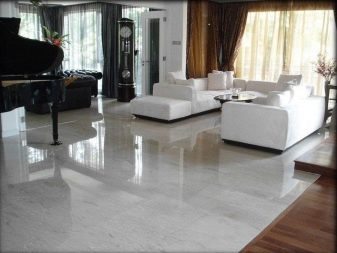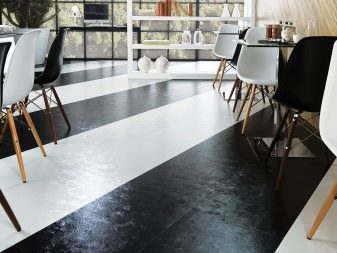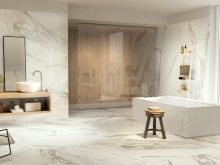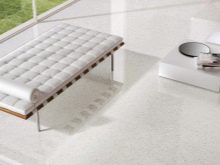White stoneware: texture features

Porcelain stoneware is an artificial stone, which, despite its name, has nothing to do with natural granite, but is not inferior in strength. Was invented on the Apennine Peninsula three decades ago. Recently, white ceramic granite is gaining popularity as a facing material.
Special features
Porcelain stoneware is not inferior in strength to natural stone and looks aesthetically attractive. The variety of textures and shades of porcelain is dictated by the characteristics of the technology of manufacturing and processing this practical material.
To create porcelain tiles used:
- White kaolin clay;
- Purified quartz sand;
- Spars;
- Natural pigments.
Cooked thick mass is poured into molds and processed. The technologies for the production of ceramic tiles and porcelain tiles are similar, the only difference is that ceramic granite is created using more powerful pressure - up to 460 kg / cm, firing takes place at a higher temperature - up to 1300 C. As a result, a more dense substance is formed, in which less micropores, so porcelain is stronger than ceramic tiles.
White color tile provide metal oxides - cobalt, zirconium, chromium, which are added to the prepared mixture. Depending on the time of their interaction with clay, shades of different brightness are obtained. No one managed to get an absolutely pure color, the maximum whiteness of porcelain stoneware is 72%.
Advantages:
- You can create any texture and shade.
- The color of all ceramic plates is uniform throughout the volume.
- It has a high coefficient of water resistance.
- It has good resistance to temperature and humidity.
- Does not interact with aggressive chemicals.
- Possesses high density, does not give in to external mechanical influences.
- Environmentally friendly.
Types of white porcelain
White artificial stone always creates the perfect backdrop for any interior, it can be:
Matt - one of the most durable facing materials, is used almost everywhere, especially in rooms where there is high humidity and temperature differences. It withstands mechanical loads well, often revealing floors of rooms with high attendance with matte artificial stone.
Glossy - the material is grinding. In terms of strength, polished porcelain tile is inferior to matte; during operation, its surface is required to be treated with various compositions that support gloss;
Satin finish - possesses a pleasant matte shade, differs in the high durability. Before heat treatment the surface is coated with mineral salt. It does not tolerate mechanical loads, it is used primarily as a decorative facing material.
Rectified - it is cut by special technology, the surface after laying has no seams;
Glazed - before firing, the surface is coated with special enamel, after heat treatment, such an artificial stone is difficult to distinguish from marble;
Lapped - The name comes from the Italian "lappato", translated as "shabby." After firing, the material undergoes special processing: the grinder cuts the upper layers in some areas, the surface becomes rough or polished in some places.
In the market there is a large selection of white artificial stone from different manufacturers. It is famous for good quality and high sales of porcelain tiles from Germany and Italy. Chinese facing material, due to low prices, is also in great demand.
The most expensive of all is porcelain, which reproduces natural stone. Among the expensive white tiles - imitations of rare types of marble, various textures - wood, leather, fabric. The original solution and the higher the degree of whiteness, the higher the price will be.
Color and texture solutions
There is no 100% white ceramic granite, the technology does not allow suppression of coloring pigments during firing.Most often, the term “white porcelain stoneware” means various tones: ivory, baked milk, etc. The possible degree of whiteness is in the range from 50 to 70-72%.
In spite of all the advantages of the brightest porcelain stoneware, facing the floor or walls only with such an artificial stone is not the best idea, the effect will be too “dazzling”
By design distinguish:
- Monochrome or monocolor - absolutely monophonic material without stains and inclusions, has a uniform color across the tile, the grain is almost imperceptible. The brightest, whitest, most expensive. There are models where staining is present only in the upper layer; this type of porcelain stoneware monocolour is cheaper.
- Achromatic - for white ceramic granite in this case we are talking about light. subtle shades of natural stone: pale green, pink, etc.
- Salt pepper - the surface is interspersed with a little lighter or darker base. Mostly light colors prevail. Often, the floors of this material can be found in business centers, they look restrained and personable. Often the "salt-pepper" is additionally polished, framed and decorated by them halls of hotels or concert halls.
Marble will always remain a classic material that has an infinite number of variations. The most popular are achromatic and light shades. Lapped and polished artificial stone has the greatest saturation and depth.
The salt-pepper porcelain tile has the lowest price of the white tile family: the cheapest components are used to make such an artificial stone.
Dimensions
The size of the tile depends on its intended use: for external or internal work. What matters is the type of finish, operating conditions, the indicator of the room permeability, etc. The thickness of a regular product is in the range - from 7 mm to 10, for external cladding - from 12 to 20 mm.
White square tile is available in various sizes, the most common: 15x15 cm; 30x30 cm; 45x45 cm; 75x75 cm; 95x95 cm
Some custom sizes are in high demand: 15x30; 30x45; 30x60; 120x40; 120x15; 120x30
The maximum size of porcelain stoneware is most often used for cladding the external walls of objects - 1200x600 mm.
Application
It is quite difficult for a layman to distinguish marble from porcelain stoneware, while marble costs more.Given this fact, you can save a lot of money, and the strength and quality of the finish will not be affected.
White granite revetted: terraces, halls, bathrooms, even bedrooms. The white color is the foundation that collects all the other colors in the composition. As an example, we can recall the Scandinavian interiors, hi-tech, techno style, commercial loft. White floor visually expands the room.
It is forbidden to combine dark walls and white floor: there is a distortion of the size of the room. If a room is large, it is customary to zone the floor with porcelain stoneware of darker shades.
If the apartment is decorated in a rustic style - eco, Provence, it is often chosen for the floor porcelain tiles, reproducing bleached wood. Its embossed surface looks super natural.
Effectively looks floors, in which there are inclusions of various shades. In recent years, the design of the tile has been very popular, and it has been successfully applied in its products by Mezon: white porcelain tile is combined with bright color splashes: red, yellow, blue and black.
A set of colors can be arbitrary or grouped according to a specific algorithm.Such collections are distinguished by simplicity and charm.
Tips for choosing
The texture and color of white porcelain can vary. Nowadays super white porcelain tiles of the brand VS-70 are in fashion, which can harmoniously be present almost everywhere in the interior. Contrasting compositions of super white porcelain stoneware come with black tiles, on its background the material looks very bright and stylish.
The price of porcelain stoneware is directly proportional to the fact of what percentage of the mass is dyed with the main color, which does not affect the strength and durability of the material. Manufacturers produce double-pressed ceramic granite, such an artificial stone has a good whiteness coefficient, but costs less.
You can learn about the features of porcelain stoneware and how to choose it correctly from the following video.



















































